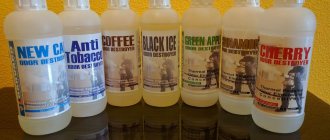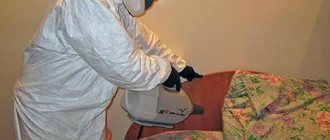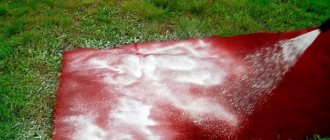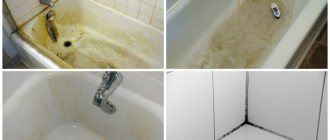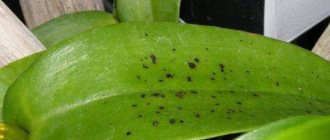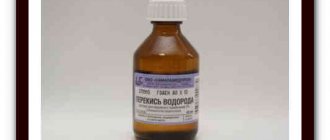There are a lot of creatures in the world that can create a lot of inconvenience for humans. One of them is termites. Just a few years are enough for these insects to completely destroy all the supporting structures of a house made of wood. Therefore, if you also own a wooden house, you need to find out how to deal with termites.
Insects that have taken up residence in your home may not reveal themselves for a long time. And only when their “works” become noticeable, it may already be very late.
Fighting termites in a wooden house
Reliable protection of structures and structures requires expensive and time-consuming measures. The secretive lifestyle and special manner of absorption of cellulose lead to the fact that termites can live in a house for a long time, remaining completely unnoticed. For the first 5 years after the settlement of “white ants”, the consequences of their destructive “works” may not even be seen, but then it will simply be too late.
Therefore, first of all, it is necessary to take all possible steps to protect the house from herbivorous insects, and if they are already infested, then get rid of termites as soon as possible.
To effectively deal with uninvited “tenants”, you need to know their characteristics, strengths and weaknesses, and therefore know as much as possible about them.
Organic termite killers
Dust and powder. Another way is to dry out insects using special dust, for example, diatomaceous earth or silica aerogel. They crash into the chitinous cover of insects and penetrate inside, drawing fluid from the body. The dust is safe for humans as long as it is not inhaled. To avoid irritation of mucous membranes, use a mask and safety glasses. However, scientists have differing opinions about the effectiveness of diatomaceous earth. Some recognize it as effective, others do not. Most likely, the answer lies in one of its features: diatomaceous earth loses its effectiveness even with low humidity. Therefore, it can only be used for termites in dry wood.
Natural enemies. Sometimes it is not necessary to deal with termites yourself. You can break into their passages made from the colony to the feeding areas, after which natural enemies of termites, for example, ants, can get into them.
Another enemy is Nematodes. The idea is to attack the enemy with his own weapon. Nematodes parasitize insects. They must penetrate the host's body and, therefore, destroy it. The termite lives 48 hours after infection. The disadvantage is that the nematodes themselves soon die. These worms can be purchased on Amazon.com. Scanmask 10 Million Live Beneficial Nematodes: ~$12.99.
Termites and their types
Termites belong to the category of primitive social herbivorous insects. They are relatives of cockroaches. “White ants” got their name because of the coloring of the workers, and these insects differ from real ants in the absence of a narrow constriction separating the chest from the abdomen.
Regions of distribution
The largest colonies of termites live in tropical and subtropical regions, with smaller numbers found in warm temperate regions.
Important! According to various studies, termites cause economic damage amounting to several billion dollars a year, and the consequences of an invasion of these insects are sometimes catastrophic. For example, in South America, due to the constant presence of “white ants”, it is rare to find a book older than 50 years in cities.
Nutrition
Before getting rid of termites, it is a good idea to know what they feed on. The main food of termites is cellulose, which is found in wood, tree leaves and grass. Therefore, when termites get into a house, they can cause significant economic damage, because they are not limited to wood, but eat everything that has a high proportion of cellulose.
In their natural environment, termites eat dead branches and rotting parts of tree trunks. A number of their species feed on cereals, collecting their dry shoots in the chambers of their underground nests (termite mounds). Some termites feed on dead leaves and humus from tropical soils.
Types of termites
Like all social insects that live in colonies, termites are divided into 3 main groups:
- Working individuals.
- Soldiers.
- Individuals capable of sexual reproduction.
Activity
An adult in termites develops from a larva without first transforming into a pupa (incomplete metamorphosis). Only reproductive individuals have wings. At the base of the wing of such insects there is a seam along which the wings break off after settling for the purpose of reproduction.
Working individuals do not have genital organs, and it is the working termites that have a whitish and light color, which gives the name “white ants” to the insects.
The main task of the soldiers is to protect the colony from ant predators. To do this, they have different defense weapons:
- growth with a poisonous secretion;
- gnawing mandibles.
Important! Insect nests can be found in different places: tree trunks, stumps, logs, on the ground. Termites do not like light, so they spend almost their entire lives in the dark. Since these insects cannot feed only on what is located next to the colony, they have a need to build covered galleries, thanks to which they communicate with food objects: trees, buildings, etc.
In what natural area do termites live?
Where do termites live? The number of their species on the planet is close to three thousand, the main part lives in the subtropical and tropical zones. There are only two species represented on the territory of Russia, and they can be found in the area of Vladivostok and Sochi.
These insects live in huge multimillion-strong groups called colonies; in each of them there is a clear division into castes: workers (the majority), soldiers, queen and king. The body color of adult termites varies from whitish-yellow to black.
Sources
- https://BeetleStop.ru/termityi-v-dome/
- https://autogear.ru/article/222/337/termityi—chto-eto-takoe-gde-obitayut-termityi-i-chem-oni-pitayutsya/
- https://fb.ru/article/222337/termityi—chto-eto-takoe-gde-obitayut-termityi-i-chem-oni-pitayutsya
- https://apest.ru/nasekomye/termity/
- https://KlopSOS.ru/nasekomye/termity-i-ih-koloniya/
- https://beyklopov.ru/muravi/obshie-svedeniya-muravi/termit.html
[collapse]
How to detect termites?
To purposefully get rid of termites, you need to find the places where they live. Insects eat not only wood, but also everything made from it: wooden tools, window sills, railings, ceilings, ornamental plants, books, etc.
Important! If you have not seen direct evidence of an insect infestation, this does not mean that you need to remain indifferent to the problem, because sagging floors and small holes in the wooden elements of the house, as well as voids in supporting structures, are already serious signs of the presence of termites.
You can identify termites in the following ways:
- Look through the woodwork in your home: You may see small, round holes in some places.
- Examine the subfloor and foundation supports. Using a screwdriver, check for voids and check the entire wood for strength. If the tree gives in easily and falls into pieces, then there is a problem with the presence of uninvited “tenants”.
- Note the small piles of rubbed wood underneath the woodwork.
- Check for tiny black, tan, or reddish-brown termite droppings. The presence of droppings on weakened wood members indicates a termite infestation.
- Inspect the outside and inside of the foundation walls for the presence of ground passages. Underground insects create a system of passages from the soil, and arboreal insects build a termite mound inside wooden structures.
- Check whether the wooden frame of the house is damaged at the height of the first floor, especially at the junction of the foundation and walls, as well as under the front door.
- Inspect everything carefully with a flashlight: if the damage is not noticeable from the outside, then tap the wood with the handle of a large screwdriver (large awl) for the presence of voids.
- Determine what kind of termites you have: subterranean or arboreal. The first ones live in the ground and in the wooden structures of the house, while the second ones live only in wood. In addition to wooden structures, subterranean termites can live in woodpiles and manure piles near the house. Subterranean termites cause much more significant damage than wood termites, so different means may be needed to combat them.
Important! Termites do not like light, so look for them in all darkened areas of your home that do not receive daylight.
How to get rid of termites at home?
If you find uninvited “guests” in your home, it is better to contact a special company that has experience in destroying termites. But if you are still confident in your abilities, then use the following methods to destroy termites.
Method #1 - cardboard trap
- Moisten a couple of cardboard sheets with water.
- Stack the sheets one on top of the other.
- Place them in areas where termites are likely to live. Since the food of insects is cellulose, this will be an excellent bait for them.
- Once the termites have filled the cardboard sheets, take them to a safe place and burn them.
- Repeat the procedure as many times as needed.
Important! The trap will not solve the problem as a whole, but it will help get rid of termites in the amount of a hundred or two individuals. And to inflict more serious damage, combine this method with other methods of fighting.
Method No. 2 - nematode worms
Primordial worms are natural parasites of garden pests, including termites. Nematodes invade a host organism for their own development, such as termite larvae, and kill them within 48 hours. Nematodes use the body of insects as a breeding site.
Important! If you decide to take this step to get rid of termites, consider the following useful tips:
- You can buy worms at your local garden center or online. Today there are 5 varieties of these worms.
- If you use nematodes in soil with temperatures above 15 C, then do this immediately after purchase.
- If you do not use the worms right away, store them in the refrigerator and place them in the ground early in the morning or after sunset, since ultraviolet radiation is very harmful to these worms.
Method No. 3 - sunlight
If termites are infested not in the structure of the house itself, but in some furniture or interior item, then expose the product to sunlight, which will kill the insects. Place the furniture in an open place in sunny weather for 2-3 days.
Important! This method works best when combined with a cardboard trap to lure out and then kill the insects.
Method No. 4 - cold
If you live in a rainy region and rarely get sunshine, then use an alternative option - freezing furniture. If possible, disassemble the furnishings and place them in a large freezer for 2-3 days.
Important! Although this method is quite difficult to apply in relation to large elements of furniture, it guarantees the death of termites.
Method No. 5 - insecticidal agents
You can spray and treat the places where termites are found with poisons: “Imidacloprid”, “Chlorfenapyr”, “Chlorpyrifos”, “Fipronil”, etc.
Important! Insecticides are not toxic to humans, but are carcinogenic and can cause serious health problems in other animals where they are used.
The most commonly used and effective method of controlling termites in a wooden house at home is the use of boric acid, which kills the nervous system of insects by dehydrating it. You can use boric acid in the following way:
- As bait. Apply boric acid (or a solution) to wood or other cellulose-containing material.
- Ready-made baits can also be placed directly into the termite nest.
Important! Check the bait regularly and replenish it with boric acid.
Method #6 - Lubricating termite detection areas
Locations of dangerous insects can be lubricated with the following means:
- A mixture of boron powder with honey and sugar. Add a drop of water to the mixture to form a paste. Termites will come into contact with the mixture and carry it into their den, infecting the entire colony.
- A mixture of turpentine and kerosene in a ratio of 1:3.
- A saturated solution of naphthalene in gasoline.
- 200 parts turpentine + 100 parts tar + 15 parts creosote + 30 parts naphthalene.
- 100 parts alcohol + 3 parts sublimate.
- Tar water with an admixture of boric acid and borax (2-4 percent).
- 100 parts of kerosene + 100 parts of drying oil + 25 parts of naphthalene + 15 parts of naphthalene.
- 100 parts of turpentine + 10 parts of naphthalene + 5 parts of phenol + 3 parts of Lysol + 10 parts of wood tar.
Important! In addition to the above recipes, you can find many other coatings that need to be used to treat insect locations. Many of them do help get rid of termites quickly, but it all depends on how large the population is.
Method No. 7 - carbonation
To combat termites and other woodworms, a method of gassing wooden elements has been known since ancient times:
- Carbon disulfide.
- Hydrocyanic (cyanic) acid.
- Chloropicrin.
If you decide to use this method to get rid of termites, consider the following requirements:
- Rules for aeration, as well as building codes, recommend flameless smoke bombs that are made of HCH (hexachlorocyclohexane) or DDT (dichlorodiphenyltrichloroethane) with a flammable filler.
- Before the gasification process, all rooms must be cleared of people, animals, and food, and all cracks must be sealed with alabaster mortar and wax paper.
- All openings, ventilation ducts, vents of stoves, hearths, and the like are tightly closed, and the room is sealed.
- The duration of aeration is 3-5 days.
- After treatment, the premises are thoroughly ventilated, and the holes on the surface of the wooden structures are sealed.
Important! Gasation has not become widespread in residential buildings due to a number of disadvantages: some chemicals are very poisonous and affect human health. In addition, the penetration of gas into the thickness of wooden structures, into wooden beams walled up in stone walls, is limited, which means the destructive effect is greatly reduced.
Method No. 8 - help from professionals
If the termite infestation is too severe and your home is too important to you to give the termite pests a second chance, we recommend contacting a pest control company. In this case, specialists will professionally and efficiently, and most importantly - with a guarantee, treat the premises infested with insects.
Some companies provide a power of attorney, according to which the customer has the right to free regular inspections of the premises that have already been treated. The duration of such an arrangement can last from 1 to 2 years. Before contacting any company, you should:
- Study reviews about the company's work.
- Receive at least three offers from competing companies.
- Inquire about methods and means of treating the premises.
- Make sure the products you use are safe.
- Inquire about a written guarantee that the house will be free of termites for 2 years after disinfestation.
Helpful Tips:
- Most professional insect repellent products are commercially available, so for a small amount you can carry out pest control yourself without spending money on professional services.
- The destruction of wood borers that have already developed in the wood of the structure must be carried out comprehensively, using structural and chemical measures. Treatment must be carried out before the beetles leave wooden structures and their larvae approach the outer layers of wood. This usually happens in the spring.
- Simultaneously with the fight against termites, it is necessary to carry out anti-rot repairs of buildings and all structures.
Important! You cannot limit yourself to exterminating insects in a particular building; they should be destroyed in their nests. For example, in Central Asia, termite mounds have been filled with fuel oil or oil since ancient times, and K. Escherich suggests pumping the termite mound with a mixture of sulfur and arsenic vapor.
Folk remedies
If chemicals do not suit you, then there are alternative ways to kill white ants using folk remedies:
- Expand the area where termites are opening and spray liquid nitrogen there. The cold will spread and destroy the pests, or they will hastily leave the house.
- Place the furniture in the freezer or put it in the cold for a day. The insects will not withstand the frost and will die.
- The natural enemies of termites are nematode worms. Find a termite mound and add nematodes there. After some time, the entire colony will die.
Termites are able to live in a wooden house for several years and during this time destroy buildings to the extent that they collapse and only the foundation remains. Therefore, you should quickly take measures to protect your home and area from such pests.
Termite preventatives
In order not to search for a remedy for termites, it is better to take preventive measures:
- When building a house, the following nuances must be taken into account:
- The dwelling must be on a high foundation. All wooden structures must be located above ground level and not in contact with it.
- It is necessary to install good drainage around the house so that the ground around the home is not too wet, because termites are attracted to damp and damp environments and require water to survive.
- Be sure to check with the builders what kind of wood termites do not like. It could be cedar or redwood.
- During construction, use special films that are laid on brick and other walls. They serve as a barrier to termites and other unwanted insects.
- If the house has already been built, then to reduce humidity and for a reliable barrier that prevents insects from entering the home, dig a trench at least 1 m deep and wide around the entire perimeter of the house. Fill it with sand (termites move along the ground and will not dig a path through the sand) . For greater reliability and effectiveness, treat the sand with some insecticides or other improvised means against wood-boring insects.
- Make sure all pipes and drains in and around your home are not leaking. Remove any unwanted moisture as it accumulates.
- Clean your gutters regularly, as they are an ideal haven for termites.
- In the room itself, ensure reliable ventilation so that excess moisture does not remain in the house.
- Reinstall the wooden fence around the house on a raised surface made of cement so that the wood does not come into contact with the ground.
- Treat all places where wood comes into contact with the outside environment, especially the bottom of the wooden walls of the house, wooden thresholds at the entrance to the house and the joints of the corners of wooden walls with coatings, the recipes for which were outlined above.
- Seal all cracks and crevices in the walls of the house with sealant to prevent termites from entering the room.
- When building or painting a house, add 0.1% permethrin to paint or varnish (1 tablespoon per 10 liters of water). This will discourage termites from approaching your home.
Important! Add permethrin to cement when leveling the floor or to glue if you are laying wood flooring. The product is absolutely safe for humans
.
- Do not store firewood and other wooden materials in close proximity to your home, as such storage actually invites termites into your home. If you need firewood near your house or bathhouse, cover it completely. This will ensure they dry completely and make them less attractive to insects. Firewood can also be treated with permethrin.
- Anti-mosquito nets on doors, balconies and windows will also be useful.
- It is better to transplant shrubs growing near the house further away, if possible, so that the moisture in their roots does not attract termites to the house. If it is not possible to replant the plants, then try not to wet the walls of the house when watering.
Important! You can get rid of termites in a bathhouse using the same methods and means as in the house, but remember that removing them from the site, and even more so from wood, is quite difficult. Therefore, do not ignore preventive measures; treat all wood with antiseptics, which will repel not only termites, but also wood-destroying beetles and fungi.
